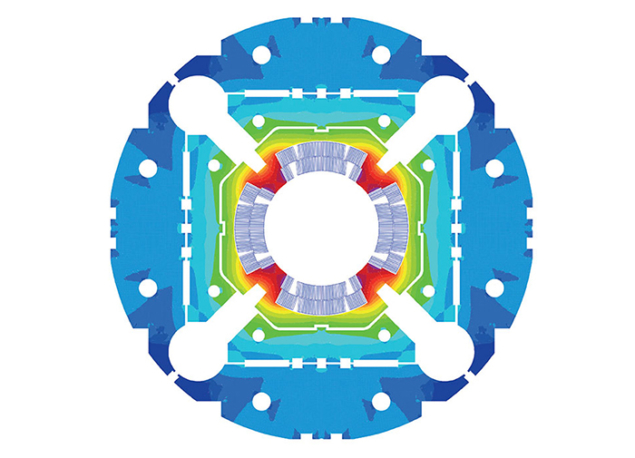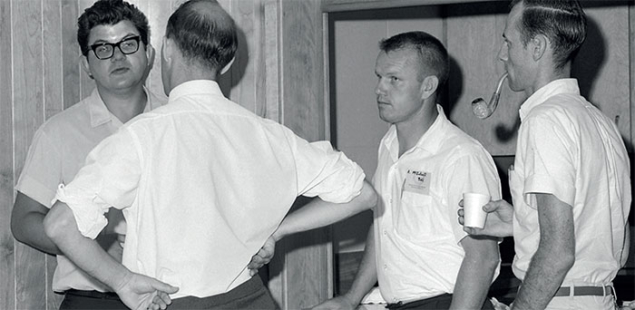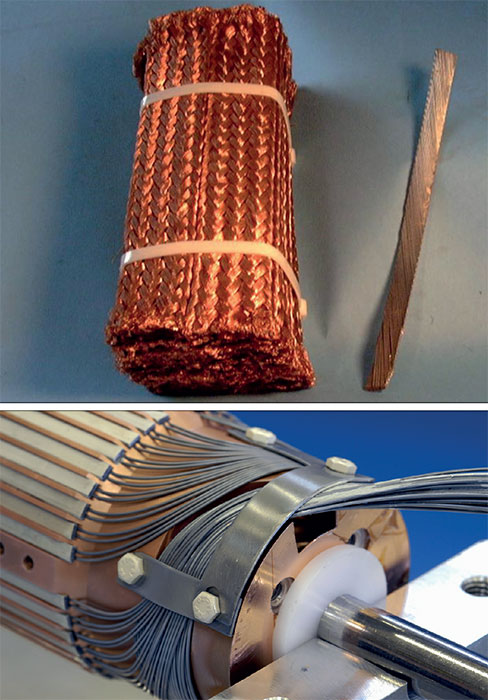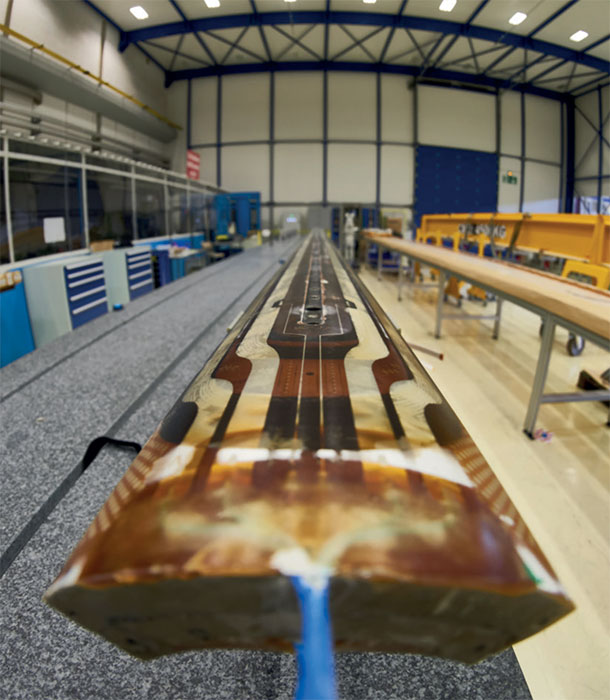High-field superconducting magnets continue to drive accelerators.

Image credit: CERN/US-LARP.
Particle physicists try to understand the environment that existed fractions of a second after the Big Bang by studying the behaviour of particles at high energies. Early studies relied on cosmic rays emanating from extraterrestrial sources, but the invention of the circular accelerator by Ernest Lawrence in 1931 revolutionised the field. Further advances in accelerator technology gave physicists more control over their experiments, in particular thanks to the invention of the synchrotron and the development of storage rings. By capturing particles via a ring of magnets and accelerating them with radio-frequency cavities, these facilities finally reached energies of a few hundred GeV. But storage rings are limited by the maximum magnetic field achievable with resistive magnets, which is around 2 T. To go further into the heart of matter, particle physicists required higher energies and a new technology to get them there.
The maximum field of an electromagnet is roughly determined by the amount of current in a conductor multiplied by the number of turns the conductor makes around its support structure. Over the years, the growing scale of accelerators and the large number of magnets needed to reach the highest energies demanded compact and affordable magnets. Conventional electromagnets, which are usually based on a copper conductor, are limited by two main factors: the amount of power required to operate them due to resistive losses and the size of the conductor. Typical conventional-magnet windings therefore tended to use conductors with a cross-sectional area of the order of a few square centimetres, which is not optimal for generating high magnetic fields.
Superconductivity, which allows certain materials at low temperatures to carry very high currents without any resistive loss, was just the transformational technology needed. It powered the Tevatron collider at Fermilab in the US to produce the top quark, and CERN’s Large Hadron Collider (LHC) to unearth the Higgs boson. Advanced superconducting magnets are already being developed for future collider projects that will take physicists into a new phase of subatomic exploration beyond the LHC (figure 1).
Maintaining the state
Discovered in 1911, superconductivity didn’t immediately lead to broad applications, particularly not high-field accelerator magnets. As far as accelerators were concerned, the possibility of using superconducting magnets to produce higher fields started to take root in the mid-1960s. The big challenge was to maintain the superconducting state in a bulk object in which tremendous forces are at work: the slightest microscopic movement of the conductor would cause it to transition to the normal state (a “quench”) and result in burn-up, unless the fault was detected quickly and the current turned off.

Image credit: L Rossi, P Lebrun.
Early superconductors were mostly formed into high-aspect-ratio tapes measuring a few tenths of a millimetre thick and around 10 mm wide. These are not particularly useful for making magnets because precise geometry and current distribution are necessary to achieve a good field quality. Intense studies led to the development of multi-filamentary niobium-zirconium (NbZr), niobium-titanium (Nb-Ti) and niobium-tin (Nb3Sn) wires, propelling interest in superconducting technology. In 1961, Kunzler and colleagues at Bell Labs produced a 7 T field in a solenoid, a relatively simple coil geometry compared with the dipoles or quadrupoles needed for accelerators. This swiftly led to higher-field solenoids, and a number of efforts to utilise the benefits of superconductivity for magnets began. But it was only in the early 1970s that the first prototypes of superconducting dipoles and quadrupoles demonstrated the potential of superconducting magnet technology for accelerators.
A turning point came during a six-week-long study group at Brookhaven National Laboratory (BNL) in the US in the summer of 1968, during which 200 physicists and engineers from around the world discussed the application of superconductivity to accelerators (figure 2). Considerable focus was directed towards the possibility of using superconducting beam-handling magnets (such as dipoles and quadrupoles for transporting beams from accelerators to experimental areas) for the new 200–400 GeV accelerator being constructed at Fermilab. By that time, several high-field superconducting alloys and compounds had been produced.
Hitting the mainstream
It could be argued that the unofficial kick-off for superconducting magnets in accelerators was a panel discussion at the 1971 Particle Accelerator Conference held in Chicago, although there was a clear geographical divide on key issues. The European contingent was reluctant to delve into higher-risk technology when it was clear that conventional technology could meet their needs, while the Americans argued for the substantial cost savings promised by superconducting machines: they claimed that a 100 GeV superconducting synchrotron could be built in five or six years, while the Europeans estimated a more conservative seven to 10 years.
In the US, work on furthering the development of superconducting magnets for accelerators was concentrated in a few main laboratories: Fermilab, the Lawrence Radiation Laboratory, Brookhaven National Laboratory (BNL) and Argonne National Laboratory. In Europe, a consortium of three laboratories – CEA Saclay in France, Rutherford Appleton Laboratory in the UK and the Nuclear Research Center at Karlsruhe – was formed to enable future conversion of the recently approved 300 GeV accelerator, to become CERN’s Super Proton Synchrotron (SPS), to higher energies using superconducting magnets. Of particular historical note, a short paper written at this time referred to a “compacted fully transposed cable” produced at the Rutherford Lab, and the “Rutherford cable” has since become the standard conductor configuration for all accelerator magnets (figure 3).
Rapid progress followed, reaching a tipping point in the 1970s with the launch of several accelerator projects based on superconducting magnets and a rapidly growing R&D community worldwide. These included: the Fermilab Energy Doubler; Interaction Region (IR) quadrupoles (used to bring particles into collision for the experiments) for the Intersecting Storage Rings at CERN; and IR quadrupoles for TRISTAN at KEK in Japan and UNK in the former USSR. The UNK magnets were ambitious for their time, with a desired operating field of 5 T, but the project was cancelled in the years following the breakup of the USSR.

Image credit: BNL.
Although superconducting magnet technology was one of the initial options for the SPS, it was rapidly discarded in favour of resistive magnets. This was not the case at Fermilab, which at that time was pursuing a project to upgrade its Main Ring beyond 500 GeV. The project was initially presented as an Energy Doubler, but rapidly became known by the very modern name of Energy Saver, and is now known as the Tevatron collider for protons and antiprotons, which shut down in 2011. The Tevatron arc magnets were the result of years of intense and extremely effective R&D, and it was their success that triggered the application of superconductivity for accelerators.
As superconducting technology matured during the 1980s, its applications expanded. The electron–proton collider HERA was getting under way at DESY in Germany, while ISABELLE was reborn as the Relativistic Heavy Ion Collider (RHIC) at BNL. Thanks to intensive development by high-energy physics, Nb-Ti was readily available from industry. This allowed the construction of magnets with fields in the 5 T range, while multi-filamentary conductors made from niobium-titanium-tantalum (Nb-Ti-Ta) and Nb3Sn were being pursued for fields up to 10 T. The first papers on the proposed Superconducting Super Collider (SSC) in the US were published in the mid-1980s, with R&D for the SSC ramping up substantially by the start of the 1990s. Then, in 1991, the first papers on R&D for the LHC were presented. The LHC’s 8 T Nb-Ti dipole magnets operate close to the practical limit of the conductor, and the collider now represents the largest and most sophisticated use of superconducting magnets in an accelerator.
The niobium-tin challenge
With the success of the LHC, the international high-energy physics community has again turned its attention to further exploration of the energy frontier. CERN has launched a Future Circular Collider (FCC) study that envisages a 100 TeV proton–proton collider as the next step for particle physics, which would require a 100 km-circumference ring of superconducting magnets with operating fields of 16 T. This will be an unprecedented challenge for the magnet community, but one that they are eager to take on. Other future machines are based on linear accelerators that do not require magnets to keep the beams on track, but demand advanced superconducting radio-frequency structures to accelerate them over short distances.
Thanks to superconducting accelerator magnets wound with strands and cables made of Cu/Nb-Ti composites, the energy reach of particle colliders has steadily increased. After nearly half a century of dominance by Nb-Ti, however, other superconducting materials are finally making their way into accelerator magnets. Quadrupoles and dipoles using Nb3Sn will be installed as part of the high-luminosity upgrade for the LHC (the HL-LHC) in the next few years, for example, and the high-temperature superconductor Bi2Sr2CaCu2O8 (BSCCO), iron-based superconductors and rare-earth bismuth copper oxide (REBCO) have recently been added to the list of candidate materials. Proposals for new large circular colliders has boosted interest in high-field dipole magnets but, despite the tantalising potential for achieving dipole fields more than twice that of Nb-Ti, there are many problems that still need to be overcome.

Image credits: CERN.
Although Nb3Sn was one of the early candidates for high-field magnets, and has much better performance at high fields than Nb-Ti, its processing requirements, mechanical properties and costs present difficulties when building practical magnets. Nb3Sn comes as a round wire from industry vendors, which is excellent for making multi-wire cables but requires the reaction of a copper, niobium and tin composite at 650 °C to develop the superconducting Nb3Sn cable. Unfortunately, Nb3Sn is a brittle ceramic, unlike Nb-Ti, which requires only modest heat treatment and drawing steps and is mechanically very strong. Years of effort worldwide have overcome these limitations and fields in the range of 16 T have recently been achieved – first in 2004 by a US R&D programme and more recently at CERN – and this is close to the practical limit for this conductor. In addition to the near-term use in the HL-LHC, and despite currently costing 10 times more than Nb-Ti, it is the material of choice for a future high-energy hadron collider, and is also being used in enormous quantities for the toroidal-field magnets and central solenoid of the ITER fusion experiment (see “ITER’s massive magnets enter production”).
High-temperature superconductors represent a further leap in magnet performance, but they also raise major difficulties and could cost an additional factor of 10 more than Nb3Sn. For fields above 16 T there are currently only two choices for accelerator magnets: BSCCO and REBCO. Although these materials become superconductors at a higher temperature than niobium-based materials, their maximum current density is achieved at low temperatures (in the vicinity of 4.2 K). BSCCO has the advantage of being obtainable in round wire, which is perfect for making high-current cables but requires a fairly precise heat treatment at close to 900 °C in oxygen at high pressures. This is not a simple engineering task, especially when dealing with large coils. Much progress has been made recently, however, and there is a vibrant programme in industry and academia to tackle these challenges. REBCO has excellent high-field performance, high current density and requires no heat treatment, but it only comes in tape form, presenting difficulties in winding the required coil shapes and producing acceptable field quality. Nevertheless, the performance of this high-temperature superconductor is too tantalising to abandon it, and many people are working on it. Even after half a century, progress in the development of high-field accelerator magnet R&D continues, and indeed is critical for future discoveries in particle physics.
CERN breaks records with high-field magnets for High-Luminosity LHC

To keep the protons on a circular track at the record-breaking luminosities planned for the LHC upgrade (the HL-LHC) and achieve higher collision energies in future circular colliders, particle physicists need to design and demonstrate the most powerful accelerator magnets ever. The development of the niobium-titatnium LHC magnets, currently the highest-field dipole magnets used in a particle accelerator, followed a long road that offered valuable lessons. The HL-LHC is about to change this landscape by relying on niobium tin (Nb3Sn) to build new high-field magnets for the interaction regions of the ATLAS and CMS experiments. New quadrupoles (called MQFX) and two-in-one dipoles with fields of 11 T will replace the LHC’s existing 8 T dipoles in these regions. The main challenge that has prevented the use of Nb3Sn in accelerator magnets is its brittleness, which can cause permanent degradation under very low intrinsic strain. The tremendous progress of this technology in the past decade led to the successful tests of a full-length 4.5 m-long coil that reached a record nominal field value of 13.4 T at BNL. Meanwhile at CERN, the winding of 7.15 m-long coils has begun.Several challenges are still to be faced, however, and the next few years will be decisive for declaring production readiness of the MQFX and 11 T magnets. R&D is also ongoing for the development of a Nb3Sn wire with an improved performance that would allow fields beyond 11 T. It is foreseen that a 14–15 T magnet with real physical aperture will be tested in the US, and this could drive technology for a 16 T magnet for a future circular collider. Based on current experience from the LHC and HL-LHC, we know that the performance requirements for Nb3Sn for a future circular collider require a large industrial effort to make very large-scale production viable.
• Panagiotis Charitos, CERN.








